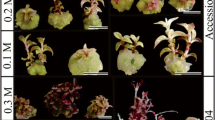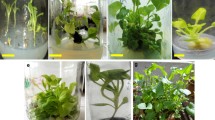Abstract
Bud emergence and shoot growth from adult phase citrus nodal cultures were studied using Citrus mitis (calamondin), Citrus paradisi (grapefruit), and Citrus sinensis (sweet orange). The effects of 6-benzyladenine (BA), indole 3-acetic acid (IAA), and citrus type on shoot quality and growth of mature bud explants from greenhouse grown trees were determined using a 2-component mixture-amount × citrus type experiment. BA increased shoot number and IAA improved shoot growth. The best shoot quality (fewer shoots but large shoots) was obtained with 1 μM IAA for calamondin, 15.5 μM IAA for sweet orange, and 30 μM IAA for grapefruit. Grapefruit exhibited substantial leaf abscission compared to calamondin and sweet orange. Four factors (AgNO3, silver thiosulphate (STS), CaNO3, or gelling) were screened individually for their efficacy in reducing leaf abscission. Five factors (AgNO3, gelling, MS ion concentration, plant growth regulator and venting) were investigated to identify potential combinations for reducing leaf abscission and maximizing shoot growth and bud emergence. The factor combination identified as most effective in minimizing leaf drop, promoting shoot growth, and maximizing bud emergence for grapefruit was 2 mg l−1 AgNO3, Gelrite, 1 × MS ion concentration, 30 μM IAA, and vented.




Similar content being viewed by others
Abbreviations
- IAA:
-
Indole 3-acetic acid
- BA:
-
6-benzyladenine
- MS:
-
Murashige and Skoog
- STS:
-
Silver thiosulphate
References
Al Khayri JM, Al-Bahrany AM (2001) In vitro micropropagation of Citrus aurantifola (Lime). Curr Sci 81:1242–1246
Anderson MJ, Whitcomb PJ (2005) RSM simplified: optimizing processes using response surface methods for design of experiments. Productivity Press, New York
Barlass M, Skene KGM (1982) In vitro plantlet formation from Citrus species and hybrids. Sci Hortic 17:333–341
Begum F, Amin MN, Azad MAK (2004) A comparative study of axillary shoot proliferation from the nodal explants of three varieties pummel (Citrus grandis (L.) Osb.). Biotechnology 3:56–62
Beyer EM Jr (1976) A potent inhibitor of ethylene action in plants. Plant Physiol 58:268–271
Box GEP, Cox DR (1964) An analysis of transformations. J R Stat Soc Series B 26:211–252
Cervera M, Juarez J, Navarro A, Pina JA, Duran-Vila N, Navarro L, Pena L (1998) Genetic transformation and regeneration of mature tissues of woody fruit plants bypassing the juvenile stage. Transgenic Res 7:51–59
Cervera M, Navarro A, Navarro L, Pena L (2008) Production of transgenic adult plants from Clementine mandarin by enhancing cell competence for transformation and regeneration. Tree Physiol 28:55–66
Cornell JA (2002) Experiments with mixtures: designs, models and the analysis of mixture data, 3rd edn. John Wiley Inc, New York
Duran-Vila N, Ortega V, Navarro L (1989) Morphogenesis and tissue culture of three citrus species. Plant Cell Tissue Org Cult 16:123–133
Evens TJ, Niedz RP (2008). Are Hofmeister series relevant to modern ion-specific effects research? Scholarly Research Exchange vol. 2008, Article ID 818461, doi:10.3814/2008/818461
George EF, Hall MA, Klerk GJD (2008) Plant propagation by tissue culture, 3rd edn. Springer, Dordrecht, The Netherlands
Hansen LN, Funnell KA, Mackay BR (1996) Silver thiosulphate reduces ethylene-induced flower shattering in Thalictrum delavayi. N Z J Crop Hortic Sci 24:203–205
Kozai T, Kubota C, Zobayed S, Nguyen QT, Afreen-Zobayed F (2000) Developing a mass propagation system for woody plants. In: Watanabe K, Komamine A (eds) Challenge of plant and agricultural sciences to the crisis of biosphere on the earth in the 21st century. Chap. 28:289–302. Landes Biosphere, Texas, USA
Marin ML, Duran-Vila N (1991) Conservation of citrus germplasm in vitro. J Am Soc Hortic Sci 116:740–746
Mendes BMJ, Cardoso SC, Boscariol-Camargo RL, Cruz RB, Mourão Filho FAA, Bergamin Filho A (2010) Reduction in susceptibility to Xanthomonas axonopodis pv. citri in transgenic Citrus sinensis expressing the rice Xa21 gene. Plant Pathol 59:68–75
Murashige T, Skoog F (1962) A revised medium for rapid growth and bioassays with tobacco tissue culture. Physiol Plant 15:473–497
Niedz RP, Bausher MG (2002) Control of in vitro contamination of explants from greenhouse-and field-grown trees. In Vitro Cell Dev Biol Plant 38:468–471
Niedz RP, Evens TJ (2006) A solution to the problem of ion confounding in experimental biology. Nat Methods 3:417
Perez-Tornero O, Tallon CI, Porras I (2009) An efficient protocol for micropropagation of lemon (Citrus limon) from mature nodal segments. Plant Cell Tissue Org Cult 100:263–271
Rodriguez A, Cervera M, Peris JE, Pena L (2008) The same treatment for transgenic shoot regeneration elicits the opposite effect in mature explants from two closely related sweet orange (Citrus sinensis (L.) Osb.) genotypes. Plant Cell Tissue Org Cult 93:97–106
Smith WF (2005) Experimental design for formulation. ASA-SIAM
Spiegel-Roy P, Goldschmidt EE (1990) Biology of horticultural crops biology of citrus. Cambridge University Press, New York
Acknowledgments
We thank Marjory Faulkner, Carrie Kahr, and Dave Lindsey for horticultural maintenance and care of greenhouse citrus trees. We thank Eldridge Wynn and Jessica Dennis for providing plant tissue culture technical assistance, advice, and laboratory maintenance. This research was supported by a grant from the Florida Citrus Advanced Technology Program of the Florida Citrus Production Research Advisory Council (NAS 144).
Author information
Authors and Affiliations
Corresponding author
Additional information
The use or mention of a trademark or proprietary product does not constitute an endorsement, guarantee, or warranty of the product by the US Department of Agriculture and does not imply its approval to the exclusion of other suitable products.
Rights and permissions
About this article
Cite this article
Marutani-Hert, M., Evens, T.J., McCollum, G.T. et al. Bud emergence and shoot growth from mature citrus nodal stem segments. Plant Cell Tiss Organ Cult 106, 81–91 (2011). https://doi.org/10.1007/s11240-010-9896-0
Received:
Accepted:
Published:
Issue Date:
DOI: https://doi.org/10.1007/s11240-010-9896-0




